Material and Spiritual Belongings for First Cycle
First: Welcome the children into the session. Say how happy we are to see them and how important they are for the class. Explain we will grab a letter from the bag which contains letters from the entire alphabet. Each child will have a turn to grab a letter from the bag. So, the child’s name that starts with the letter that was ‘chosen’ do the opening prayer this week.
The Spiritist worker will introduce the “Raffle Box of Prayers” after that. In his/her turn each child will open the box, choose one prayer and read it loudly for the entire class. We will do it until all the kids have their chance to choose and read a prayer. The volunteer should assist the younger ones.
When the activity with the “Raffle box of Prayers” finishes the volunteer will collect the booklet “The Lord’s Prayer” from the child who was responsible to bring it back from the previous week.
The volunteer can ask questions like:
* What did you like most in this prayer;
* What could you learn during the week with the prayer
The child can also read the prayer for his/hers colleagues. Another child will be able to choose himself/herself to take the booklet home and bring it back on the following week, at the end of this activity.
The Lord’s Prayer booklet
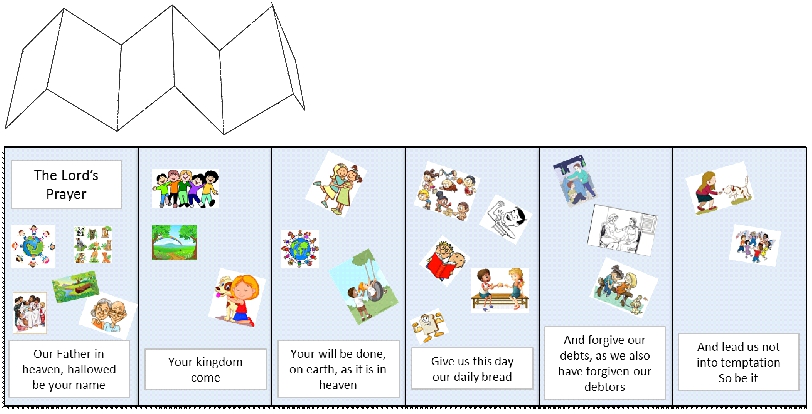
P.S. At the end of the class the parents will be informed and also asked about their availability to bring the booklet next week.
Second: The volunteer will discuss with the children about the prayer “Prayer for my friend who is ill” from the book LEARNING HOW TO PRAY – A BOOK OF PRAYERS FOR CHILDREN by Elsa Rossi. Each one will also receive a copy of the prayer.
Prayer for Peace (Part 1)
Dear Jesus, I don’t like wars.
I see my Dad praying and I’m trying to do the same but with my words.
I still don’t know how to pray properly, as I am still learning.
Dear Jesus, may your light illuminate the hearts of those people that make war.
Third: The volunteer will bring the following quotes written down on pieces of paper and ask each child to pick one and read it to the rest of the group
1. "Averting war is the work of politicians; establishing peace is the work of education."--Maria Montessori
2. "What is Peace? Is it war? No. Is it strife? No. Is it lovely, and gentle, and beautiful, and pleasant, and serene, and joyful? O yes!"--Charles Dickens
3. "There never was a good war or a bad peace."--Benjamin Franklin
4. “Peace I leave with you, My peace I give to you; not as the world gives do I give to you. Let not your heart be troubled, neither let it be afraid.” Jesus, John 14:27
5. “These things I have spoken to you, that in Me you may have peace. In the world you will have tribulation; but be of good cheer, I have overcome the world.” Jesus, John 16:33
6. “Be anxious for nothing, but in everything by prayer and supplication, with thanksgiving, let your requests be made known to God; and the peace of God, which surpasses all understanding, will guard your hearts and minds through Christ Jesus.” Paul, Philippians 4:6-7
Fourth: The volunteer will ask the children to define the word “peace”; their answers will probably be very enlightening. The volunteer will help leading them to notice they can have a hand in creating a peaceful environment wherever they are.
Peace may look a little different to everyone. It could be argued it is learning how to deal with conflict in a way that doesn’t put the rights, wants, or needs of one person over the other. It’s learning conflict resolution skills that stress respect for the individual and the group.
Fifth: The volunteer will discuss conflict resolution skills through role-playing. The volunteer will ask the children to make a list of unresolved conflicts; or issues that come up that could have been better resolved. Talk about peaceful ways to resolve the conflict. You can define and discuss compromise, taking turns, and listening skills.
One conflict resolution technique that children love is to have one object in the classroom or home that is always used when children are resolving conflict. Children face each other (or sit in a circle) and whoever is holding the object gets to talk. No one can interrupt, and once the object is passed on, the next person gets to talk exclusively. The volunteer will bring a couple of objects which will be used as examples so the children can practice.
Sixth: Create a storyboard – Get them to come up with a conflicting issue and how they managed to get it sorted in the end of the story. They will need to draw the story and later share it with the rest of the group.
Seventh: RActivity, taken from the website Montessori Education Week - Peace Lesson: http://www.montessori-opportunities.com/peace_lesson
* Show the children the word "Peaceful"
* Ask the children what makes a peaceful person
* Acknowledge their contributions
* Show the children the letter "P" ask the children for words that begin with "P" that describe a peaceful person
* Record the words and place them beside the "P"
* Continue - show the next letter - the "E"
* Again ask for words that begin with "E" that make a peaceful person
* Continue with each letter until you have spelled out PEACEFUL
Here’s an example taken from the site:
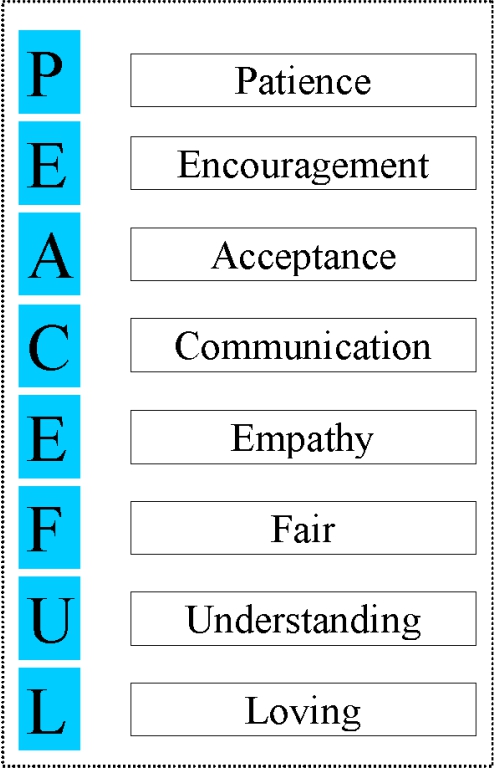
Eighth: Matching Card’s Game – Match the phrase with the appropriate picture
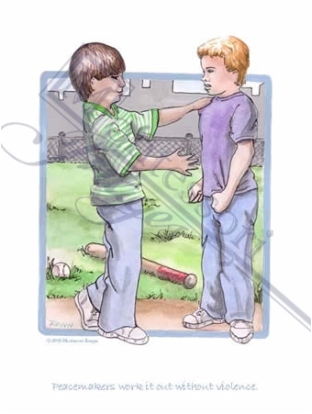
Peacemakers work it out without violence.
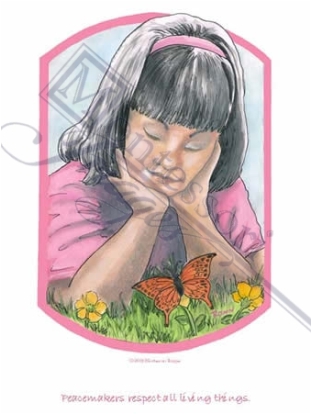
Peacemakers respect all living beings.
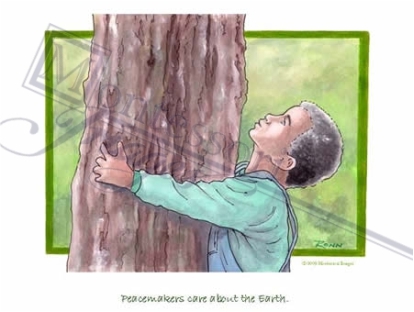
Peacemakers care about the earth.
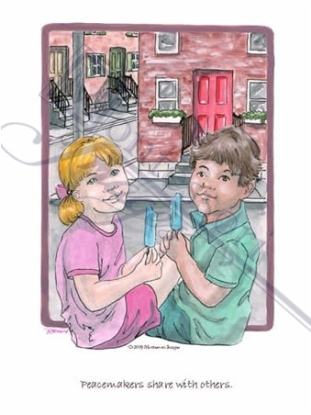
Peacemakers share with others.
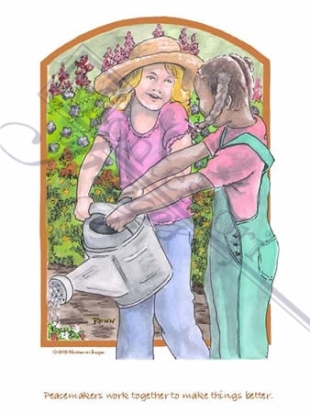
Peacemakers work together to make things better.
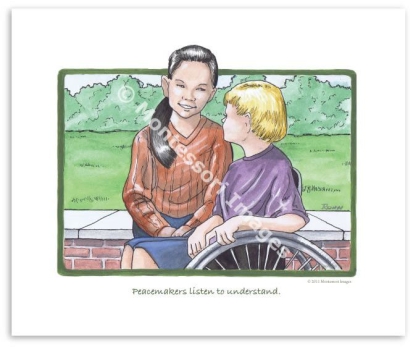
Peacemakers listen to understand.
Ninth: Activity – The children will need to find the resolution for the Code for Pain presented with a Code for Peace. Please note this activity was taken from the internet.
http://www.freemontessori.org/wp-content/uploads/2009/10/code_for_peace.pdf
http://www.freemontessori.org/wp-content/uploads/2009/10/code_for_pain.pdf
Tenth: Read one question from The Little Spirits’ Book Laura Bergallo. Translation: Jussara Korngold, Mônica Santos, Lorena Suppa, Fred Lima, and Danny Claudio.
Eleventh: Healing Time - Prepare the kids for the healing time. Put one chair at the centre of the room and ask one child of each time to seat on the chair and show how he/she should behave upstairs.
Twelfth: Preparation for closing prayer - Kids should choose a passage from the: Gospel According to the Spiritism for the kids, The Spirits’ Book for kids or the Heaven or Hell. The volunteer will encourage the others kids to volunteer themselves for reading and give a quickly comment about it.
Thirteenth: Closing prayer - One of the children will do a closing prayer; encourage the children to volunteer for this task. If they don’t want to collaborate we could say we will follow the letters of the alphabet. The child’s name that starts with the letter A will do the opening prayer this time. Everybody will have the chance to collaborate.
Suggested activity to be given as Homework:
Class suggested being suitable for: 1st Cycle (7 to 8 years old).
Spiritist volunteer: Juana Castro, London, linked to The Spiritist Psychological Society.


[Classes]
|
[Print]










